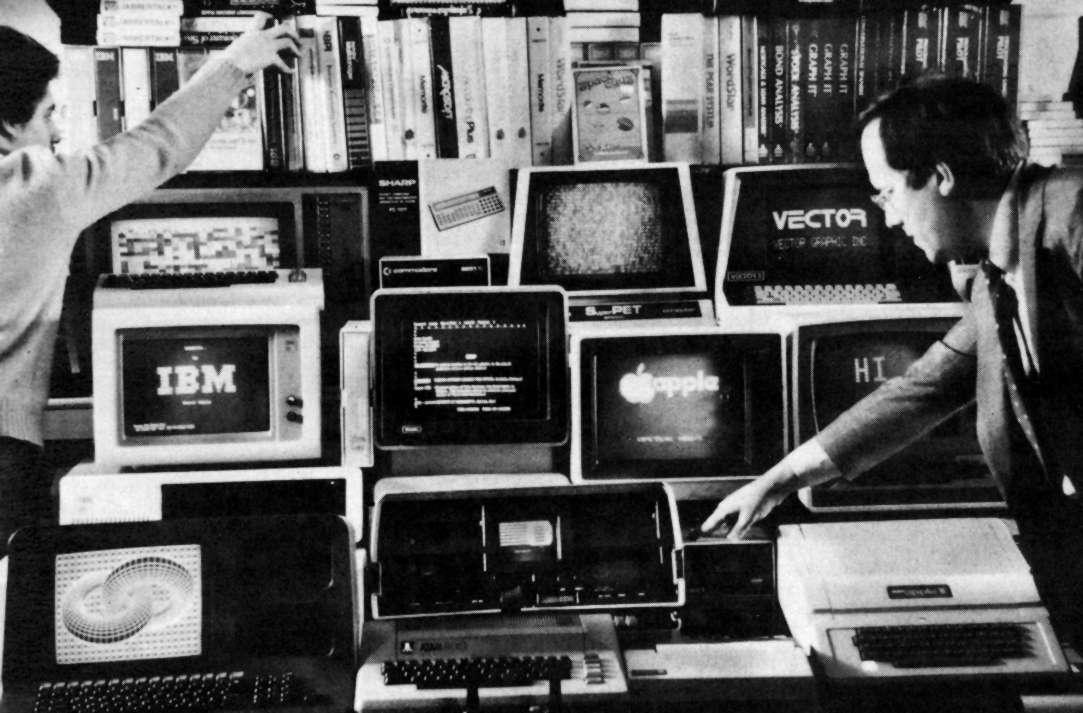 Back to GanjaTron's Site
Back to GanjaTron's Site
What is Retrocomputing?

| Computer shopping in the early 80's. Among the recognisable systems is an Apple ][, an Atari 800, an Osborne 1, an IBM PC, and a Commodore SuperPET [Click to enlarge]. |
In today's age where the computing landscape is dominated by The One And Only OS (which shall remain unnamed), long-time users yearn for those good old days when it was populated not by one, but by a variety of systems, each embodying its own design philosophy and technology. Those were the days when computing was a multicoloured field and computers had -- dare I say it -- personality! It was the day and age of Real Programmers™ capable of coding directly in machine language without an assembler! These were the days when you didn't buy your software (mainly because there was little, if any) but wrote it yourself! Computing wasn't so much a necessity as today, but merely an engaging hobby. Having access to a computer, or even owning one, was a rare privilege indeed. At a time when computer literacy was low, that made you a member of an exclusive club.
Furthermore, people were perfectly content with the capabilities of their machines, no matter how modest they may seem by today's standards. More importantly, programmers were forced to make the most of the hardware and developed some ingenious solutions. In effect, the limitations imposed on the programmer resulted in some remarkable software -- necessity was the mother of invention. The programmer was forced to write efficient code which barely fit in the machine's memory. The most prominent example that comes to my mind is Peter Jennings' Microchess, which ran on a KIM-1 with 1K (that's one kilobyte!) of memory.
Today's programmers could learn a lot from that, since the concept of efficiency appears to be largely lost on them. They don't care about wasted CPU cycles; after all, today's hardware is fast enuff, right? Well, in some cases it isn't (Mozilla comes to mind), and makes you wonder if they actually added code to make it crawl on a modern, ultra fast, power hungry PC (quite a programming feat in itself), presumably to force you to buy even faster hardware. The simple fact is: no matter how powerful the hardware, today's programmers will always find a way to bog it down with sloppy code. So much for progress.
Nowadays every schmuck has a PC (mainly just for games), yet doesn't know (nor care) what makes it tick. Today's Generation Click™ users are mostly ignorant of the evolution of the personal computer and can't relate to the concept of retrocomputing. As far as they're concerned (and this is no exaggeration), the "PeeCee" (as an Intel architecture) and The One And Only OS have always been around, and of course there was no internet before the WWW. Everybody knows that, right? Gimme a break...
Every now and then when us long-time users get PC-weary we get back to the roots and spend some time with the classic computers we cut our teeth on. To this end I've accumulated a small collection of vintage computing equipment (partly originally my own), dating mostly from the late 70s to mid 80s. Yes, there are emulators for these systems, but nothing beats the look and feel of the original hardware. An emulator can't convey such factors as the feel and metallic ring of a sturdy vintage keyboard, the smell and snap crackle and pop of the PCBs warming up, and those mysterious crashes and resets due to flaky connectors! :^)
You may well ask what you can actually do with that hardware nowadays. I think the question of utility of such equipment that's way beyond its use-by date is purely academic. You certainly won't develop anything fancy on it. Occasionally it's just a game or two, or just messing around with BASIC or assembler for old time's sake, simply to escape the mundane modern computing world. More importantly however, you study the design of these machines, particularly the hardware and firmware, and put them in their historical context in order to realise how we got where we are today. These systems are our computing heritage, and I personally feel they should be preserved as such long after they have served their purpose. To some of course, like many of my peers, I have an emotional attachment, as they're also a part of our adolescent lives, sometimes bringing back bittersweet memories. About 64K's worth. :^)
The links below point to the individual pieces in the collection, which I've categorised according to the niche they fill. More will be added as they come in and/or as I Get A Round Tuit™.
Home / Personal Computers
Apple ][+Sinclair ZX81 & Timex/Sinclair 1000
1st Generation Laptops
Epson HX-20Single Board Computers and Trainers
MOS KIM-1Programmable Calculators / Pocket Computers
Casio fx-6000GCasio fx-790P
Hewlett Packard HP-28S
Texas Instruments TI-66
 Back to GanjaTron's Site
Back to GanjaTron's Site